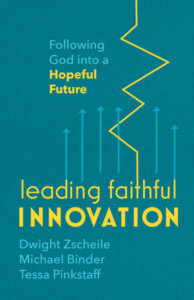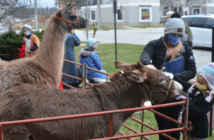Incredible things happen when congregations commit to being present in and praying for the spaces around them. The authors of a new book, Leading Faithful Innovation, share how a neighborhood prayer walk led one church to life-giving relationships and new ways of demonstrating God’s love.
Incredible things happen when congregations commit to being present in and praying for the spaces around them. A group of people from an urban church went on a Prayer Walk in a neighborhood near where the church worshipped. Many of them had never been on a Prayer Walk before. They were probably wondering things like What do you even do on a Prayer Walk? Do you pray out loud the whole time you are walking? Do you pray for people on the street? Do you just pray silently as you walk?
These are understandable questions, and as the church group created a plan for where they were going to walk, they decided their goal would be to pay careful attention to what was around them as they traveled together. They remained open to letting God reveal important observations about the neighborhood.
The church team encountered different parts of the landscape now that they were walking instead of driving, including a couple of large apartment buildings. One of the buildings had a reception desk near the entrance, so they went in to inquire about how the building was used. The staff member told them the building was part of a local organization focused on providing affordable housing for people who were experiencing HIV/AIDS. It was a low-profile, private residence where people sharing similar experiences could live together in community with the goal of promoting health and safety. The people from the church who first learned about the building returned to the congregation and shared their discoveries. As more groups conducted Prayer Walks, all of the teams shared what they were noticing so everyone could benefit from their listening work in the neighborhood.
From prayer walk to life-giving relationships
A few months later, the church got a call from the affordable housing organization asking if people from the congregation could provide Christmas gift bags for their residents with gloves, hats, and other basic essentials, and cookies. While the organization made it clear the church couldn’t include Bibles or any material advertising the church, the congregation saw this as an opportunity to love their neighbors. They agreed to provide the bags.
As time passed, the people from the church began to feel as though God was leading them to explore the possibility of building relationship with the residents. They asked for permission to offer a monthly meal. The building had a community room that was designed for communal meals, so the church asked if they could host it there to make it easier for people to come. The building director said yes. Soon, a group of faithful church members regularly hosted the meal. Over many months, the turnout varied. Sometimes many residents came, and sometimes just a few turned up. The group wondered if the monthly meal program was effective. But they kept doing it because they believed God wanted them to continue building relationships.
Months later, the local neighborhood association called the church to ask for help. They were trying to survey all the people who lived in the area to determine how excess funding from a budget surplus should be spent. The neighborhood association had heard that the church had a relationship with the residents in this building. They had been unable to get them to respond, and they wanted to make sure their voices were included.
The congregation was ready to act. When the neighborhood association offered several thousand dollars, the church used the money to host an outdoor party in the building’s courtyard. It was open to everyone, with food, games, and even a puppet show. Many residents came and many filled out the survey. The church members were amazed at the opportunity they felt like God gave them through this moment. The neighborhood they prayed for and walked through had reached out to them, offering them funding to ensure that often-overlooked voices were heard. What started with a Prayer Walk had culminated into life-giving relationships. All this transpired because a few people noticed the building and took steps to explore what was happening there.
Learning from the community and demonstrating God’s love
The story didn’t end there. Relationships continued to grow between the residents and people from the church. Some residents came to worship at the church. When one of the residents passed away, one of the pastors was invited to provide a memorial service for him at the building. Many people from the building attended and heard about his Christian faith.
It was a tremendous honor for the church to help create a space where this person’s life could be celebrated by those who cared about him. The congregation saw how God had clearly invited them into this community learn from the residents and also demonstrate Gods love for them. It can sometimes be hard to discern whether to keep doing something, and the early volunteers persevered because they perceived God’s call. We never know how God might use a practice like a Prayer Walk to open up opportunities for relationship and ministry. Listening for God’s leading often does not follow a straight line. Instead, God calls our attention to people and places that we may never have noticed. This is an important part of the faithful innovation journey.
 Excerpted from Leading Faithful Innovation: Following God into a Hopeful Future (Fortress Press, 2023) by Dwight Zscheile, Michael Binder, and Tessa Pinkstaff. The book is available at Fortress Press, Cokesbury, and Amazon.
Excerpted from Leading Faithful Innovation: Following God into a Hopeful Future (Fortress Press, 2023) by Dwight Zscheile, Michael Binder, and Tessa Pinkstaff. The book is available at Fortress Press, Cokesbury, and Amazon.
Related Resources
- Leading Faithful Innovation featuring Dwight Zscheile featuring Ben Connelly — Leading Ideas Talks podcast episode | Podcast video | In-depth interview
- Listening to Your Community by Paul Nixon
- How One-to-One Conversations Reintroduced a Church to its Neighbors by Travis Norvell
- A Spiritual Approach to Community Assessment by Luke Edwards
Image by Freepik







